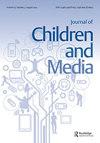The influence of sources in violent news on fright and worry responses of children in the Netherlands
IF 2.1
3区 心理学
Q2 COMMUNICATION
引用次数: 0
Abstract
ABSTRACT Children display fright and worry responses to violent news. Including involved children, non-involved children or experts as sources in children’s news is assumed to reduce these negative effects. However, exemplification theory gives reason to question whether particularly the use of involved children indeed has a reassuring effect. To test this, an experiment was conducted among 237 children (8–13 y/o). They were randomly exposed to a news video containing (1) involved children as source, (2) non-involved children, or (3) adult experts. Fright and worry responses were measured both before and after exposure. Results showed that the inclusion of involved children as a source significantly increased worry responses, but did not affect fright responses. Non-involved child sources significantly reduced fright and worry responses. Expert sources reduced children’s fright responses, but did not change feelings of worry. These insights can inform news producers on how to alleviate the effects of covering violent events in news. IMPACT SUMMARY a. Prior State of Knowledge: Violent content in news induces negative responses in children. Producers of children’s news try to alleviate these effects by using involved children, non-involved children, or adult experts as sources in violent news stories. b. Novel Contributions: This study provides first empirical insights into the effects of involved children, non-involved children, and adult experts as sources in violent news stories on children’s fear and worry responses. It shows how to alleviate children’s negative emotional responses to news. c. Practical Implications: News producers are encouraged to use non-involved children or adult experts when presenting violent news to children. They should be careful with the inclusion of involved children as sources in news stories.暴力新闻来源对荷兰儿童恐惧和担忧反应的影响
摘要儿童对暴力新闻表现出恐惧和担忧的反应。将参与的儿童、非参与的儿童或专家作为儿童新闻的来源被认为可以减少这些负面影响。然而,例证理论让人有理由质疑,尤其是使用相关儿童是否确实有令人放心的效果。为了验证这一点,在237名儿童(8-13岁)中进行了一项实验。他们被随机暴露在一个新闻视频中,该视频包含(1)参与的儿童作为来源,(2)未参与的儿童,或(3)成人专家。在暴露前后测量恐惧和担忧反应。结果表明,将参与的儿童作为一个来源显著增加了担忧反应,但不影响恐惧反应。未涉及的儿童来源显著减少了恐惧和担忧反应。专家来源减少了孩子们的恐惧反应,但并没有改变他们的担忧感。这些见解可以让新闻制作人了解如何减轻新闻中报道暴力事件的影响。影响总结a.先前的知识状态:新闻中的暴力内容会引起儿童的负面反应。儿童新闻的制作人试图通过使用参与的儿童、非参与的儿童或成人专家作为暴力新闻的来源来减轻这些影响。b.新颖贡献:这项研究首次提供了关于参与儿童、非参与儿童和成人专家作为暴力新闻报道来源对儿童恐惧和担忧反应的影响的实证见解。它展示了如何减轻儿童对新闻的负面情绪反应。c.实际意义:鼓励新闻制作人在向儿童介绍暴力新闻时使用不参与的儿童或成人专家。他们应该小心将参与其中的儿童作为新闻报道的来源。
本文章由计算机程序翻译,如有差异,请以英文原文为准。
求助全文
约1分钟内获得全文
求助全文

 求助内容:
求助内容: 应助结果提醒方式:
应助结果提醒方式:


